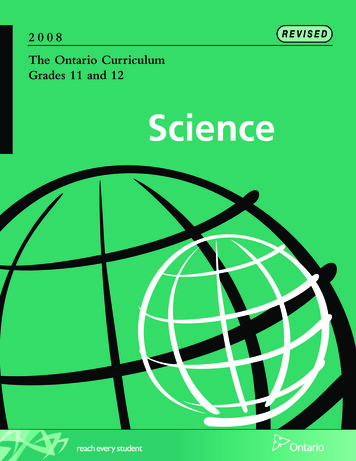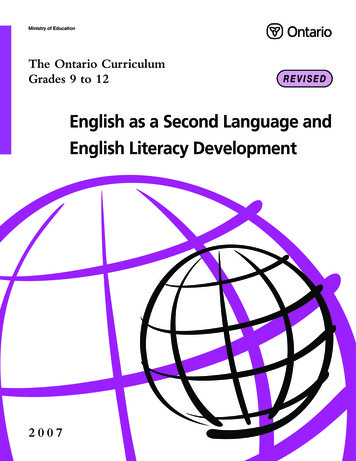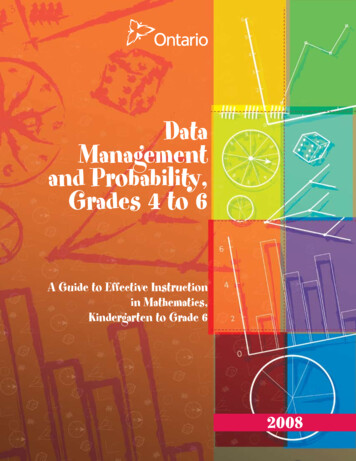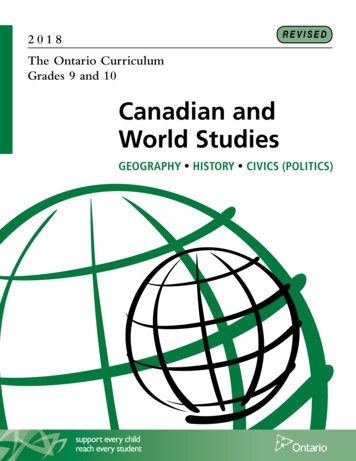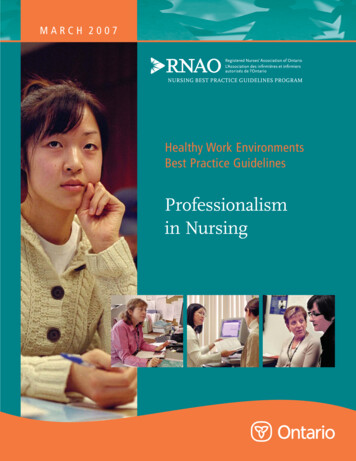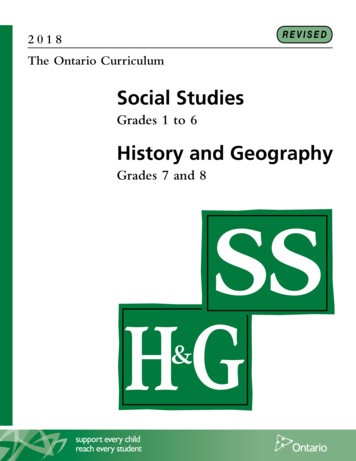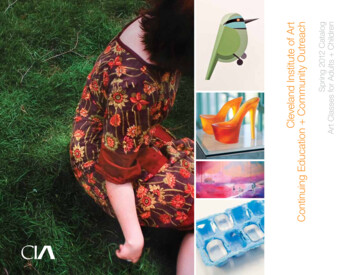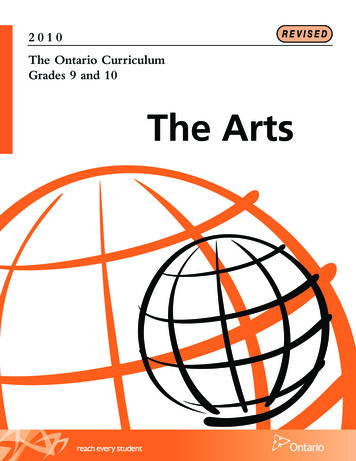
Transcription
REVISED2010The Ontario CurriculumGrades 9 and 10The Arts
CONTENTSINTRODUCTION3Secondary Schools for the Twenty-First Century . . . . . . . . . . . . . . . . . . . . . . . . . . . . . . . .The Importance of the Arts Curriculum . . . . . . . . . . . . . . . . . . . . . . . . . . . . . . . . . . . . . . . . .Ideas Underlying the Arts Curriculum . . . . . . . . . . . . . . . . . . . . . . . . . . . . . . . . . . . . . . . . . . .Roles and Responsibilities in the Arts Program . . . . . . . . . . . . . . . . . . . . . . . . . . . . . . . . . .Attitudes in the Arts . . . . . . . . . . . . . . . . . . . . . . . . . . . . . . . . . . . . . . . . . . . . . . . . . . . . . . . . . . . .THE PROGRAM IN THE ARTS335579Overview of the Program . . . . . . . . . . . . . . . . . . . . . . . . . . . . . . . . . . . . . . . . . . . . . . . . . . . . . . . 9Curriculum Expectations . . . . . . . . . . . . . . . . . . . . . . . . . . . . . . . . . . . . . . . . . . . . . . . . . . . . . . 12Strands in the Arts Curriculum . . . . . . . . . . . . . . . . . . . . . . . . . . . . . . . . . . . . . . . . . . . . . . . . 14The Creative Process . . . . . . . . . . . . . . . . . . . . . . . . . . . . . . . . . . . . . . . . . . . . . . . . . . . . . . . . . . 14The Critical Analysis Process . . . . . . . . . . . . . . . . . . . . . . . . . . . . . . . . . . . . . . . . . . . . . . . . . . . 16ASSESSMENT AND EVALUATION OF STUDENT ACHIEVEMENT21Basic Considerations . . . . . . . . . . . . . . . . . . . . . . . . . . . . . . . . . . . . . . . . . . . . . . . . . . . . . . . . . . 21The Achievement Chart for the Arts: Grades 9–12 . . . . . . . . . . . . . . . . . . . . . . . . . . . . . . 24Information on the Achievement Chart . . . . . . . . . . . . . . . . . . . . . . . . . . . . . . . . . . . . . . . . 26SOME CONSIDERATIONS FOR PROGRAM PLANNING IN THE ARTSInstructional Approaches . . . . . . . . . . . . . . . . . . . . . . . . . . . . . . . . . . . . . . . . . . . . . . . . . . . . .Planning Arts Programs for Students With Special Education Needs . . . . . . . . . . . .Program Considerations for English Language Learners . . . . . . . . . . . . . . . . . . . . . . .Environmental Education and the Arts . . . . . . . . . . . . . . . . . . . . . . . . . . . . . . . . . . . . . . . .Healthy Relationships and the Arts . . . . . . . . . . . . . . . . . . . . . . . . . . . . . . . . . . . . . . . . . . . .Equity and Inclusive Education in the Arts Program . . . . . . . . . . . . . . . . . . . . . . . . . . . .Multiple Literacies in the Arts . . . . . . . . . . . . . . . . . . . . . . . . . . . . . . . . . . . . . . . . . . . . . . . . .Literacy, Mathematical Literacy, and Inquiry/Research Skills . . . . . . . . . . . . . . . . . . . .Critical Thinking and Critical Literacy in the Arts . . . . . . . . . . . . . . . . . . . . . . . . . . . . . . .The Role of the School Library in the Arts Program . . . . . . . . . . . . . . . . . . . . . . . . . . . .The Role of Information and Communications Technologyin the Arts Program . . . . . . . . . . . . . . . . . . . . . . . . . . . . . . . . . . . . . . . . . . . . . . . . . . . . . . . . . . .Une publication équivalente est disponible en français sous le titre suivant : Le curriculumde l’Ontario, 9e et 10e année – Éducation artistique, 2010This publication is available on the Ministry of Education’s website, at http://www.edu.gov.on.ca.292930323536363839404142
The Ontario Skills Passport and Essential Skills . . . . . . . . . . . . . . . . . . . . . . . . . . . . . . . . .Career Education . . . . . . . . . . . . . . . . . . . . . . . . . . . . . . . . . . . . . . . . . . . . . . . . . . . . . . . . . . . . . .Cooperative Education and Other Forms of Experiential Learning . . . . . . . . . . . . . .Planning Program Pathways and Programs Leading to a SpecialistHigh Skills Major . . . . . . . . . . . . . . . . . . . . . . . . . . . . . . . . . . . . . . . . . . . . . . . . . . . . . . . . . . . . . .Health and Safety in the Arts Program . . . . . . . . . . . . . . . . . . . . . . . . . . . . . . . . . . . . . . . . .Ethics in the Arts Program . . . . . . . . . . . . . . . . . . . . . . . . . . . . . . . . . . . . . . . . . . . . . . . . . . . . .COURSESDANCE43434344444549Overview . . . . . . . . . . . . . . . . . . . . . . . . . . . . . . . . . . . . . . . . . . . . . . . . . . . . . . . . . . . . . . . . . . . . . . 49Dance, Grade 9, Open (ATC1O) . . . . . . . . . . . . . . . . . . . . . . . . . . . . . . . . . . . . . . . . . . . . . . . . 51Dance, Grade 10, Open (ATC2O) . . . . . . . . . . . . . . . . . . . . . . . . . . . . . . . . . . . . . . . . . . . . . . . 58DRAMA65Overview . . . . . . . . . . . . . . . . . . . . . . . . . . . . . . . . . . . . . . . . . . . . . . . . . . . . . . . . . . . . . . . . . . . . . . 65Drama, Grade 9, Open (ADA1O) . . . . . . . . . . . . . . . . . . . . . . . . . . . . . . . . . . . . . . . . . . . . . . . 67Drama, Grade 10, Open (ADA2O) . . . . . . . . . . . . . . . . . . . . . . . . . . . . . . . . . . . . . . . . . . . . . . 74INTEGRATED ARTS81Overview . . . . . . . . . . . . . . . . . . . . . . . . . . . . . . . . . . . . . . . . . . . . . . . . . . . . . . . . . . . . . . . . . . . . . . 81Integrated Arts, Grade 9 or 10, Open (ALC1O/ALC2O) . . . . . . . . . . . . . . . . . . . . . . . . . . 82MEDIA ARTS89Overview . . . . . . . . . . . . . . . . . . . . . . . . . . . . . . . . . . . . . . . . . . . . . . . . . . . . . . . . . . . . . . . . . . . . . . 89Media Arts, Grade 10, Open (ASM2O) . . . . . . . . . . . . . . . . . . . . . . . . . . . . . . . . . . . . . . . . . . 91MUSIC99Overview . . . . . . . . . . . . . . . . . . . . . . . . . . . . . . . . . . . . . . . . . . . . . . . . . . . . . . . . . . . . . . . . . . . . . . 99Music, Grade 9, Open (AMU1O) . . . . . . . . . . . . . . . . . . . . . . . . . . . . . . . . . . . . . . . . . . . . . . . 101Music, Grade 10, Open (AMU2O) . . . . . . . . . . . . . . . . . . . . . . . . . . . . . . . . . . . . . . . . . . . . . 109VISUAL ARTS117Overview . . . . . . . . . . . . . . . . . . . . . . . . . . . . . . . . . . . . . . . . . . . . . . . . . . . . . . . . . . . . . . . . . . . . . 117Visual Arts, Grade 9, Open (AVI1O) . . . . . . . . . . . . . . . . . . . . . . . . . . . . . . . . . . . . . . . . . . . . 119Visual Arts, Grade 10, Open (AVI2O) . . . . . . . . . . . . . . . . . . . . . . . . . . . . . . . . . . . . . . . . . . 126GLOSSARY2133
INTRODUCTIONThis document replaces The Ontario Curriculum, Grades 9 and 10: The Arts, 1999. Beginningin September 2010, all arts courses for Grades 9 and 10 will be based on the expectationsoutlined in this document.SECONDARY SCHOOLS FOR THE TWENTY-FIRST CENTURYThe goal of Ontario secondary schools is to support high-quality learning while givingindividual students the opportunity to choose programs that suit their skills and interests.The updated Ontario curriculum, in combination with a broader range of learning optionsoutside traditional classroom instruction, will enable students to better customize theirhigh school education and improve their prospects for success in school and in life.THE IMPORTANCE OF THE ARTS CURRICULUMExperiences in the arts – dance, drama, media arts, music, and the visual arts – play avaluable role in the education of all students. Through participation in the arts, studentscan develop their creativity, learn about their own identity, and develop self-awareness,self-confidence, and a sense of well-being. Since artistic activities involve intense engagement, students experience a sense of wonder and joy when learning through the arts,which can motivate them to participate more fully in cultural life and in other educationalopportunities.The arts nourish the imagination and develop a sense of beauty, while providing uniqueways for students to gain insights into the world around them. All of the arts communicate through complex symbols – verbal, visual, and aural – and help students understandaspects of life in a variety of ways. Students gain insights into the human conditionthrough ongoing exposure to works of art – for example, they can imagine what it wouldbe like to be in the same situation as a character in a play, an opera, or a painting, and tryto understand that character’s point of view. They identify common values, both aestheticand human, in various works of art and, in doing so, increase their understanding ofothers and learn that the arts can have a civilizing influence on society. In producingtheir own works, students communicate their insights while developing artistic skillsand aesthetic judgement.Through studying works of art from various cultures, students deepen their appreciationof diverse perspectives and develop the ability to approach others with openness andflexibility. Seeing the works of art produced by their classmates also helps them learnabout, accept, and respect the identity of others and the differences among people. Theopenness that is fostered by study of the arts helps students to explore and appreciate theculture of diverse peoples in Canada, including First Nations and francophones. Students3
learn that people use the arts to record, celebrate, and pass on to future generationstheir personal and collective stories and the values and traditions that make us uniqueas Canadians.Education in the arts involves students intellectually, emotionally, socially, and physically.Learning through the arts therefore fosters integration of students’ cognitive, emotional,sensory, and motor capacities, and enables students with a wide variety of learning stylesto increase their learning potential. For example, hands-on activities can challenge studentsto move from the concrete to the abstract, and the students learn that, while the arts canbe enjoyable and fulfilling, they are also intellectually rigorous disciplines. Students alsolearn that artistic expression is a creative means of clarifying and restructuring personalexperience.In studying the arts, students learn about interconnections and commonalities among thearts disciplines, including common elements, principles, and other components. Danceand drama share techniques in preparation and presentation, and require interpretive andmovement skills. Music, like dance, communicates through rhythm, phrase structure, anddynamic variation; also, both have classical, traditional, and contemporary compositionalfeatures. The visual arts, dance, and drama all share aspects of visual design, interpretation,and presentation, making connections among movement, space, texture, and environment.Media arts can incorporate and be interwoven through the other four disciplines to enhance,reinterpret, and explore new modes of artistic expression.THE ONTARIO CURRICULUM, GRADES 9 AND 10 The ArtsLinks can also be made between the arts and other disciplines. For example, symmetryin musical structure can be related to mathematical principles. Mathematics skills canbe applied to drafting a stage set to scale, or to budgeting an arts performance. Studentstaking a history course can attempt to bring an event in the past to life by reinterpreting itin their work in drama. Because all the arts reflect historical, social, and cultural contexts,students taking history, geography, and social sciences can gain insights into other culturesand periods through studying the arts of those cultures and times. Arts students can alsoapply their knowledge of historical and cultural contexts to enhance their understandingand appreciation of works of art. Dance students can make use of scientific principles ofphysical motion in their choreography.4The courses described in this document prepare students for a wide range of challengingcareers in the arts, as well as careers in which they can draw upon knowledge and skillsacquired through the arts. Students who aspire to be writers, actors, musicians, dancers,painters, or animators, for example, are not the only ones who can benefit from studyof the arts. Arts education prepares students for the fast-paced changes and the creativeeconomy of the twenty-first century. Learning through the arts develops many skills,abilities, and attitudes that are critical in the workplace – for example, communicationand problem-solving skills; the ability to be creative, imaginative, innovative, and original;the ability to be adaptable and to work with others; and positive attitudes and behaviours.For example, participation in arts courses helps students develop their ability to listen andobserve, and thus to develop their communication and collaborative skills. It encouragesstudents to take risks, to solve problems in original ways, and to draw on their resourcefulness. In arts courses, students develop their ability to reason and to think critically as wellas creatively. They learn to approach issues and present ideas in new ways, to teach andpersuade, to entertain, and to make designs with attention to aesthetic considerations.They also gain experience in using various forms of technology. In short, the knowledge
and skills developed in the study of the arts can be applied in many other endeavoursand in a variety of careers.IDEAS UNDERLYING THE ARTS CURRICULUMThe arts curriculum is based on four central ideas – developing creativity, communicating,understanding culture, and making connections. Major aspects of these ideas are outlinedin the chart below.Ideas Underlying the Arts CurriculumDevelopingCreativity developing aesthetic awarenessusing the creative processusing problem-solving skillstaking an innovative approach to a challengeCommunicating manipulating elements and forms to convey or express thoughts, feelings, messages,or ideas through the arts using the critical analysis process constructing and analysing art works, with a focus on analysing and communicatingthe meaning of the work using new media and technology to produce art works and to convey thoughts, feelings,and ideas about artUnderstandingCulture understanding cultural traditions and innovations constructing personal and cultural identity (developing a sense of self and a sense ofthe relationship between the self and others locally, nationally, and globally) making a commitment to equity and social justice and dealing with environmental issuesMakingConnections making connections between the cognitive and affective domains (expressing thoughtsand feelings when creating and responding to art works) creating and interpreting art works on their own and with others, and performingindependently and in groups making connections between the arts and other disciplines (e.g., transferring knowledge,skills, and understanding to other disciplines)ROLES AND RESPONSIBILITIES IN THE ARTS PROGRAMStudentsStudents have many responsibilities with regard to their learning. Students who makethe effort required to succeed in school and who are able to apply themselves will soondiscover that there is a direct relationship between this effort and their achievement, andwill therefore be more motivated to work. There will be some students, however, who willfind it more difficult to take responsibility for their learning because of special challengesthey face. The attention, patience, and encouragement of teachers can be extremelyimportant to the success of these students.INTRODUCTIONTaking responsibility for their own progress and learning is an important part of artseducation for all students, regardless of their circumstances. Students in arts coursesneed to realize that honing their craft is important and that real engagement with the artsrequires hard work and continual self-assessment. Through practice, and through reviewand revision of their work, students deepen their understanding of their chosen artsdiscipline. Students can also extend their learning in the arts by participating in schooland community arts activities.5
ParentsParents1 have an important role to play in supporting student learning. Studies showthat students perform better in school if their parents are involved in their education.By becoming familiar with the curriculum, parents can better appreciate what is beingtaught in the courses their daughters and sons are taking and what they are expected tolearn. This awareness will enhance parents’ ability to discuss their children’s work withthem, to communicate with teachers, and to ask relevant questions about their children’sprogress. Knowledge of the expectations in the various courses will also help parents tointerpret teachers’ comments on student progress and to work with teachers to improvetheir children’s learning.Effective ways in which parents can support their children’s learning include attendingparent-teacher interviews, participating in parent workshops, and becoming involved inschool council activities (including becoming a school council member). Parents whoencourage and monitor home practice or project completion further support their childrenin their arts studies. By attending concerts and presentations and other performances byschool ensembles and clubs, parents can demonstrate a commitment to their child’s success.Parents can also attend local arts and cultural events (such as art exhibits and concerts)with their children, whether or not their children are participating themselves. Theseevents often take place in community centres, places of worship, and public parks orschools, as well as in more formal venues, such as public galleries, museums, libraries,and concert halls. Parents can make an arts activity into a family activity, further demonstrating an awareness of and support for their child’s artistic and personal interests.TeachersTHE ONTARIO CURRICULUM, GRADES 9 AND 10 The ArtsTeachers and students have complementary responsibilities. Teachers develop appropriateinstructional strategies to help students achieve the curriculum expectations, as wellas appropriate methods for assessing and evaluating student learning. Teachers bringenthusiasm and varied teaching and assessment approaches to the classroom, addressingdifferent student needs and ensuring sound learning opportunities for every student.Using a variety of instructional, assessment, and evaluation strategies, teachers providenumerous opportunities for students to develop and refine their critical and creativeskills, problem-solving skills, and communication skills, while engaged in arts activities,projects, and exploration. The activities offered should give students opportunities torelate their knowledge of and skills in the arts to the social, environmental, and economicconditions and concerns of the world in which they live. Such opportunities will motivatestudents to participate in their communities as responsible and engaged citizens and tobecome lifelong learners.Teachers can help students understand that the creative process often requires a considerable expenditure of time and energy and a good deal of perseverance. Teachers can alsoencourage students to explore alternative solutions and to take the risks necessary tobecome successful problem solvers and creators of art work. The arts can play a key rolein shaping students’ views about life and learning. Since the arts exist in a broader socialand historical context, teachers can show students that all of the arts are affected by thevalues and choices of individuals, and in turn have a significant impact on society.1. The word parent(s) is used in this document to refer to parent(s) and guardian(s).6
Arts teachers provide students with frequent opportunities to practise and apply newlearning and, through regular and varied assessment, give them the specific feedback theyneed in order to further develop and refine their skills. By assigning tasks that promotethe development of higher-order thinking skills, teachers enable students to becomethoughtful and effective communicators. In addition, teachers encourage students to thinkaloud about their own artistic choices, and support them in developing the language andtechniques they need to assess their own learning. Opportunities to relate knowledgeof and skills in the arts to broader contexts will motivate students to learn in meaningfulways and to become lifelong learners.PrincipalsThe principal works in partnership with teachers and parents to ensure that each studenthas access to the best possible educational experience. To support student learning,principals ensure that the Ontario curriculum is being properly implemented in allclassrooms using a variety of instructional approaches. They also ensure that appropriateresources are made available for teachers and students. To enhance teaching and learningin all subjects, including the arts, principals promote learning teams and work with teachers to facilitate their participation in professional development activities. Principals arealso responsible for ensuring that every student who has an Individual Education Plan(IEP) is receiving the modifications and/or accommodations described in his or herplan – in other words, for ensuring that the IEP is properly developed, implemented,and monitored.Community PartnershipsCommunity partners can be an important resource for schools and students. They canbe models of how the knowledge and skills acquired through the study of the curriculumrelate to life beyond school. As mentors, they can enrich not only the educational experienceof students but also the life of the community.Schools and school boards can play a role by coordinating efforts with community partners.They can, for example, set up visits to art galleries, theatres, museums, and concert venues(where available), which provide rich environments for field trips and for exploration ofthe local community and its resources. Alternatively, local artists, musicians, actors, ordancers may be invited into the school. An increasing number of partnership programs –such as the Ontario Arts Council’s Artists in Education program – can assist teachersin more fully integrating arts and cultural programming into the classroom. In localeswhere there are few artists, technology can be used to provide a wealth of opportunitiesfor students to hear and see performances and art works and to contact artists.ATTITUDES IN THE ARTSINTRODUCTIONThe attitudes of everyone involved with students have a significant effect on how studentsapproach the arts. Parents can demonstrate a positive attitude towards the arts at homeand in the community, and teachers should project a positive attitude towards the arts intheir instruction. Teachers should encourage students to use their imagination and theirproblem-solving and critical-thinking skills in planning, producing, and assessing worksof art. They should also help students understand that even the most accomplished artistscontinue to put a great deal of time and effort into their work.7
Teachers can also encourage a positive attitude towards the arts by helping students learnabout careers in various areas of the arts industry. By studying art in a variety of forms,learning about artists within and outside the community, and participating in a varietyof artistic activities, students will become better informed about the possibilities for activeparticipation in the arts later in life.THE ONTARIO CURRICULUM, GRADES 9 AND 10 The ArtsStudents’ attitudes towards the arts can have a significant effect on their achievementof the curriculum expectations. Teaching methods and learning activities that encouragestudents to recognize the value and relevance of what they are learning will go a longway towards motivating students to work and to learn effectively.8
THE PROGRAM INTHE ARTSOVERVIEW OF THE PROGRAMThe arts program in Grades 9 and 10 consists of two courses in each of dance, drama,music, and visual arts, one course in media arts, and one course entitled Integrated Arts.All courses offered in Grades 9 and 10 in the arts program are “open” courses. Opencourses, which comprise a set of expectations that are appropriate for all students, aredesigned to broaden students’ knowledge and skills in subjects that reflect their interests,and to prepare them for active and rewarding participation in society. They are notdesigned with the specific requirements of universities, colleges, or the workplace in mind.Students choose courses in the arts on the basis of their interests, achievement, andpostsecondary goals.Courses in the Arts, Grades 9 and 10*GradeCourse NameCourse TypeCourse grated ArtsOpenALC1O/2O‡NoneMedia 2ONone9Visual ArtsOpenAVI1ONone10Visual ArtsOpenAVI2ONoneDanceDramaIntegrated Arts9 or 10Media Arts10MusicVisual Arts* Each Grade 9 and 10 course has a credit value of 1.** Course codes consist of five characters. The first three characters identify the subject; the fourth character identifiesthe grade (i.e., 1 and 2 refer to Grade 9 and Grade 10, respectively); and the fifth character identifies the type of course(i.e., O refers to “open”).‡ This course may be taken at either the Grade 9 or the Grade 10 level. Only one credit may be earned in this course.9
Prerequisite Charts for the Arts, Grades 9–12These charts map out all the courses in the discipline and show the links between courses and the possibleprerequisites for them. They do not attempt to depict all possible movements from course to course.DanceDanceATC1ODanceATC2OGrade 9, OpenGrade 10, OpenDramaDramaADA1ODramaADA2OGrade 9, OpenGrade 10, OpenDanceATC3MDanceATC4MGrade 11, University/CollegeGrade 12, University/CollegeDanceATC3ODanceATC4EGrade 11, OpenGrade 12, WorkplaceDramaADA3MDramaADA4MGrade 11, University/CollegeGrade 12, University/CollegeDramaADA3ODramaADA4EGrade 11, OpenGrade 12, WorkplaceIntegrated Arts / Exploring and Creating in the ArtsIntegrated ArtsALC1O/ALC2OGrade 9 or 10, OpenTHE ONTARIO CURRICULUM, GRADES 9 AND 10 The ArtsMedia Arts10Any Grade 9 or 10arts courseExploring and Creatingin the ArtsAEA3O/AEA4OGrade 11 or 12, OpenMedia ArtsASM2OMedia ArtsASM3MMedia ArtsASM4MGrade 10, OpenGrade 11, University/CollegeGrade 12, University/CollegeMedia ArtsASM3OMedia ArtsASM4EGrade 11, OpenGrade 12, WorkplaceMusicAMU3MMusicAMU4MGrade 11, University/CollegeGrade 12, University/CollegeMusicAMU3OMusicAMU4EGrade 11, OpenGrade 12, WorkplaceVisual ArtsAVI3MVisual ArtsAVI4MGrade 11, University/CollegeGrade 12, University/CollegeVisual ArtsAVI3OVisual ArtsAVI4EGrade 11, OpenGrade 12, WorkplaceMusicMusicAMU1OMusicAMU2OGrade 9, OpenGrade 10, OpenVisual ArtsVisual ArtsAVI1OVisual ArtsAVI2OGrade 9, OpenGrade 10, Open
Half-Credit CoursesThe courses outlined in the Grade 9 and 10 and Grade 11 and 12 arts curriculum documentsare designed as full-credit courses. However, with the exception of Grade 12 university/collegepreparation courses, they may also be delivered as half-credit courses.Half-credit courses, which require a minimum of fifty-five hours of scheduled instructional time, adhere to the following conditions: The two half-credit courses created from a full course must together contain all ofthe expectations of the full course. The expectations for each half-credit course mustbe drawn from all strands of the full course and must be divided in a manner thatbest enables students to achieve the required knowledge and skills in the allottedtime. A course that is a prerequisite for another course in the secondary curriculummay be offered as two half-credit courses, but students must successfully completeboth parts of the course to fulfil the prerequisite. (Students are not required tocomplete both parts unless the course is a prerequisite for another course theymay wish to take.) The title of each half-credit course must include the designation Part 1 or Part 2.A half credit (0.5) will be recorded in the credit-value column of both the reportcard and the Ontario Student Transcript.Boards will ensure that all half-credit courses comply with the conditions describedabove, and will report all half-credit courses to the ministry annually in the SchoolOctober Report.Focus CoursesThe curriculum expectations for the courses in dance, drama, music, and visual artsgiven in this document are designed to allow schools to develop courses that focus onparticular aspects or areas of the subject. The following is a list of some of the possibleareas for focus in dance, drama, music, and visual arts: dance: ballet, modern dance, African dance, jazz dance, dance composition drama: production, Canadian theatre, music theatre, acting/improvisation music: vocal jazz, instrumental music, creating music, electronic music visual arts: printmaking, sculpture, painting, ceramics, film/videoRegardless of the particular area on which a course is focused, students must be giventhe opportunity to achieve all the expectations for the course that are set out in thisdocument.There are no provisions for the development of courses that focus on particular areasin media arts. The course description in media arts provides a comprehensive outlineof the knowledge and skills that are covered in that course.THE PROGRAM IN THE ARTSA student may take more than one course for credit in the same subject and the samegrade in dance, drama, music, or visual arts, provided that the focus of the courses isdifferent. For example, a student could take two courses in music in Grade 10, earningone credit for each; the focus of one of the courses might be on vocal music and the otheron instrumental music.11
The course codes given in the chart on page 9 identify the courses for each subject thatare outlined in this document. Courses that focus on a particular area of a subject shouldbe assigned the appropriate code. A list of focus courses for the arts can be found onthe curriculum page for the arts, under the section “Resource Documents Specific tothis Subject
1. The word parent(s) is used in this document to refer to parent(s) and guardian(s). 6 THE ONTARIO CURRICULUM, GRADES 9 AND 10 The Arts Parents Parents1 have an important role to play in supporting student learning. Studies show that students perform better in school if their parents are involved in their education. By becoming familiar with the curriculum, parents can better appreciate .
